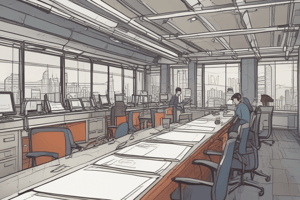Podcast
Questions and Answers
What do actors represent in a use case model?
What do actors represent in a use case model?
- Systems or persons outside the system boundary (correct)
- Special use case inherits interactions of a general use case
- Interactions with the system in a use case
- System functionality
How is the system boundary defined in a use case model?
How is the system boundary defined in a use case model?
- It represents system functionality
- It includes interaction sequence from another use case
- It delimits the system from its environment (correct)
- It inherits interactions of a general use case
What is the purpose of the 'Include' relationship in a use case model?
What is the purpose of the 'Include' relationship in a use case model?
- Increase reusability (correct)
- Represents system functionality
- Inherits interactions of a general use case
- Delimit the system from its environment
When is the 'Extend' relationship used in a use case model?
When is the 'Extend' relationship used in a use case model?
What does 'Generalization' represent in a use case model?
What does 'Generalization' represent in a use case model?
What are the different types of relationships between actors and use cases in a use case model?
What are the different types of relationships between actors and use cases in a use case model?
How can the 'Extend' relationship be used in a use case model?
How can the 'Extend' relationship be used in a use case model?
What is the purpose of the 'Include' relationship in a use case model?
What is the purpose of the 'Include' relationship in a use case model?
When is the 'Extend' relationship used to model a situation in a use case model?
When is the 'Extend' relationship used to model a situation in a use case model?
What are the interactions between actors and use cases expressed through in a use case model?
What are the interactions between actors and use cases expressed through in a use case model?
Flashcards are hidden until you start studying




